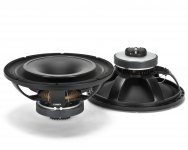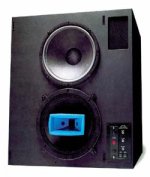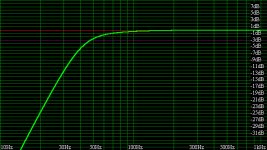In WinISD it will only take 3w to excede xmax at 10hz, 25w at 30hz. That is if im able to use the correct numbers etc.
With my current BMS 12-inch coaxials it only takes 1,5 watts to really **** off my neighbor.
90 litres tuned to 40Hz looks like a promising starting point with the Oberton 15CX. Any experience, anyone? Are their compression drivers any good? At least this would make a really compact loudspeaker for the driver size (I call those 12-inch BMS based speakers of mine "mini monitors").
Well, I didn't find anything on this particular driver, but at least someone here had good experience with their 8-inch coaxial. Others had good experience with their other drivers, giving at least hope that this 15-inch coax would be no different.
But true that these coax threads die off without any end result. Maybe try breaking the tradition this time?
But why am I so obsessed with big coaxes? Well, only one reason: Tannoy Westminster Royal. Easily the most natural drum sound I've ever heard. Easily one of the best commercial speakers I've heard. Those Magicos and Martens I can pass off as "nice", but nothing special. Other 15-inch coaxes do most of the same things I love about the Westminsters, but many PA drivers have flaws that become annoying in the long run. For example the 18sound 15NCX750 falls into this category; very nice but too flawed at the same time.
Now, the big Tannoys aren't flawless. For example I much prefer the treble performance on my current BMS 12C362 pair to any Tannoy. They just don't do enough bass. I could of course use them in a 3-way, which I've considered. But then I'd risk losing the unimitable coherence of a point source.
Actually those 18sounds were already really close to being good enough, but sadly they had a big dip in the upper midband. Still, with a 99dB/W sensitivity, 700 watts of power at hand, at least Infected Mushroom did sound very entertaining.
But true that these coax threads die off without any end result. Maybe try breaking the tradition this time?
But why am I so obsessed with big coaxes? Well, only one reason: Tannoy Westminster Royal. Easily the most natural drum sound I've ever heard. Easily one of the best commercial speakers I've heard. Those Magicos and Martens I can pass off as "nice", but nothing special. Other 15-inch coaxes do most of the same things I love about the Westminsters, but many PA drivers have flaws that become annoying in the long run. For example the 18sound 15NCX750 falls into this category; very nice but too flawed at the same time.
Now, the big Tannoys aren't flawless. For example I much prefer the treble performance on my current BMS 12C362 pair to any Tannoy. They just don't do enough bass. I could of course use them in a 3-way, which I've considered. But then I'd risk losing the unimitable coherence of a point source.
Actually those 18sounds were already really close to being good enough, but sadly they had a big dip in the upper midband. Still, with a 99dB/W sensitivity, 700 watts of power at hand, at least Infected Mushroom did sound very entertaining.
Ohms? What driver?To me it looks like a 96 db driver at 1 watt at 180 Hz ("infinite" baffle and volume). At 2.83 volts that should be 93 db at 1 meter.
Now, the big Tannoys aren't flawless. For example I much prefer the treble performance on my current BMS 12C362 pair to any Tannoy. They just don't do enough bass. I could of course use them in a 3-way, which I've considered. But then I'd risk losing the unimitable coherence of a point source.
Not in my experience.
I use 12" Tannoys with 12" woofers crossed at 250Hz.
Didn't lose any of the point-sourciness, just got bass down to 25Hz and audibly cleaner midrange.
The IMO best Tannoy speakers use a similar approach (FSM, 215DMT, Buckingham Monitor and the legendary Dreadnought).
If you like your BMS I'd just get a nice 15" to cover from where you need it to be up to 175-250Hz or so.
Keep woofer and co-axial within 1/4 of the crossover wavelength to be on the safe side.
Actually my backup plan is a three way with the BMS, but with an 18 inch bass. Something like 18Sound 18LW2400. But that's a backup plan if/when all else fails. But these would be almost prohibitively large, and might be too much for the current listening room. Our apartment leaks bass badly, and I wasn't joking when I said I only need 1,5 watts to affect neighbor relations. Couple that problem with the capacity of an 18 inch bass driver...
This is simplicity for simplicitys sake. Because simple is pretty. Or put it another way, I'm still more interested in studying this concept further than moving on to another.
This is simplicity for simplicitys sake. Because simple is pretty. Or put it another way, I'm still more interested in studying this concept further than moving on to another.
Adolf,
I know you don't like horns as you stated, but best in the LF department is RCF - CX15G251, followed by drivers Beyma and BMS (Beyma 15CXA400Nd/BMS 15CN682CXNd), for this 3 drivers and enclosure size (BR).
I'm not counting with GPA here I'm sure is one of the best. It's a decision between having a sub or not. Usually they don't go very low.
RCF - CX15G251
Beyma 15CXA400Nd (8+16Ohm)
BMS15CN682L BMS 15 CN 682 - 15" Coaxial Neodymium Speaker 500 W + 80 W 8 Ohm
1977 UREI 813 Studio Monitors | Mixonline
Altec 604 (series))
I know you don't like horns as you stated, but best in the LF department is RCF - CX15G251, followed by drivers Beyma and BMS (Beyma 15CXA400Nd/BMS 15CN682CXNd), for this 3 drivers and enclosure size (BR).
I'm not counting with GPA here I'm sure is one of the best. It's a decision between having a sub or not. Usually they don't go very low.
RCF - CX15G251
Beyma 15CXA400Nd (8+16Ohm)
BMS15CN682L BMS 15 CN 682 - 15" Coaxial Neodymium Speaker 500 W + 80 W 8 Ohm
1977 UREI 813 Studio Monitors | Mixonline
Altec 604 (series))
Attachments
Ohms? What driver?
..same one I posted, 16 ohms.
(..specifically looking for a 16 ohm driver to parallel for an average nominal 8 ohms and that 6db of gain.)
Conceptually I have problems with the cavity resonance in the midrange that those concentric horns produce.
FaitalPRO 12FH500-16, ok...same one I posted, 16 ohms.
(..specifically looking for a 16 ohm driver to parallel for an average nominal 8 ohms and that 6db of gain.)

Last edited:
Actually the Oberton 15CX is starting to look more and more attractive. Of course, simulation isn't data, but at WinISD gives an F3 of ~45Hz for the Oberton in a 100L enclosure tuned at 40Hz. That might be enough when placed in a room, since my design criterion for the bass was to reach the low E of a bass guitar, around 35Hz IIRC. This might just do it.
Another selling point is the price. At slightly under 620€ a pair, they're not prohibitively pricey to take a slight risk. A single 18Sound 15CX750 costs almost the same.
The only problem currently is I have to wait until next week for my paycheck...
Another selling point is the price. At slightly under 620€ a pair, they're not prohibitively pricey to take a slight risk. A single 18Sound 15CX750 costs almost the same.
The only problem currently is I have to wait until next week for my paycheck...
Actually the Oberton 15CX is starting to look more and more attractive.
Excellent price when considering the 1.4" exit driver.. BUT,
The high freq. linearity is pretty cr@ppy.
That's something you kind of expect with coaxes. Some of them are better, some worse. And usually just tilting them 5-10 degrees off axis takes care of that raggedy response. Varies, though.
The front axis response from a BMS 12C362 can be made surprisingly straight with a relatively simple crossover. Still not perfect, though. But keeping it within 5dB (or +-2.5dB) through 200-20kHz doesn't take too much effort. I did it, so it must be almost too easy. Now, some so-called HiFi speakers don't do that. Marten Django is an example.
Then again, you can make a seriously good speaker with an Eminence Beta 12CX and APT50. Cheap, and not providing an actually straight response. But straight enough to sound quite balanced, and with dynamics few conventional speakers with 6,5 inch "bass" drivers can provide.
Admittedly, that HF response doesn't look too flattering. But maybe I'll measure myself before condemning it as utter manure. We'll see. Might still be, that I'll decide to get the Beymas, but at least the low end response of those Obertons look more promising. And I don't trust datasheets...
The front axis response from a BMS 12C362 can be made surprisingly straight with a relatively simple crossover. Still not perfect, though. But keeping it within 5dB (or +-2.5dB) through 200-20kHz doesn't take too much effort. I did it, so it must be almost too easy. Now, some so-called HiFi speakers don't do that. Marten Django is an example.
Then again, you can make a seriously good speaker with an Eminence Beta 12CX and APT50. Cheap, and not providing an actually straight response. But straight enough to sound quite balanced, and with dynamics few conventional speakers with 6,5 inch "bass" drivers can provide.
Admittedly, that HF response doesn't look too flattering. But maybe I'll measure myself before condemning it as utter manure. We'll see. Might still be, that I'll decide to get the Beymas, but at least the low end response of those Obertons look more promising. And I don't trust datasheets...
- Home
- Loudspeakers
- Multi-Way
- The umpteenth large format coaxial driver thread



